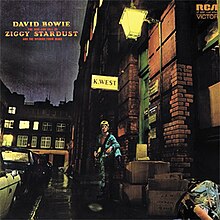The Rise and Fall of Ziggy Stardust
| The Rise and Fall of Ziggy Stardust and the Spiders from Mars | ||||
|---|---|---|---|---|
 |
||||
| Studio album by David Bowie | ||||
| Released | 16 June 1972 | |||
| Recorded | 9 July 1971; November 1971; 12–18 January 1972; 4 February 1972 | |||
| Studio | Trident Studios, London | |||
| Genre | ||||
| Length | 38:29 | |||
| Label | RCA Records | |||
| Producer |
|
|||
| David Bowie chronology | ||||
|
||||
|
Singles from The Rise and Fall of Ziggy Stardust and the Spiders from Mars |
||||
|
||||
| Professional ratings | |
|---|---|
| Review scores | |
| Source | Rating |
| AllMusic | |
| Blender | |
| Chicago Tribune | |
| Christgau's Record Guide | B+ |
| Encyclopedia of Popular Music | |
| Pitchfork Media | 10/10 |
| Q | |
| The Rolling Stone Album Guide | |
| Spin | |
| Uncut | |
The Rise and Fall of Ziggy Stardust and the Spiders from Mars (often shortened to Ziggy Stardust) is the fifth studio album by English musician David Bowie, released on 16 June 1972. It is a concept album telling the story of a fictional rock star named Ziggy Stardust. It peaked at No. 5 in the United Kingdom on the UK Albums Chart and No. 75 in the United States on the Billboard 200, then improved to a No. 21 position in the wake of Bowie's death.
The album tells the story of Bowie's alter ego Ziggy Stardust, a rock star who acts as a messenger for extraterrestrial beings. Bowie created Ziggy Stardust while in New York City promoting Hunky Dory and performed as him on a tour of the United Kingdom, Japan and North America. The album, and the character of Ziggy Stardust, was known for its glam rock influences and themes of sexual exploration and social commentary. These factors, coupled with the ambiguity surrounding Bowie's sexuality and fuelled by a ground-breaking performance of "Starman" on Top of the Pops, led to the album being met with controversy and since hailed as a seminal work.
The Rise and Fall of Ziggy Stardust and the Spiders From Mars has received critical acclaim and has been consistently considered one of the greatest albums of all time, with Rolling Stone magazine ranking it the 35th greatest ever. It was ranked the 20th greatest album ever in a 1997 British survey, the 41st greatest of all time by Q magazine and one of the 100 greatest releases ever by Time magazine. In 2017, the album was selected for preservation in the National Recording Registry, being deemed "culturally, historically, or artistically significant" by the Library of Congress.
...
Wikipedia
